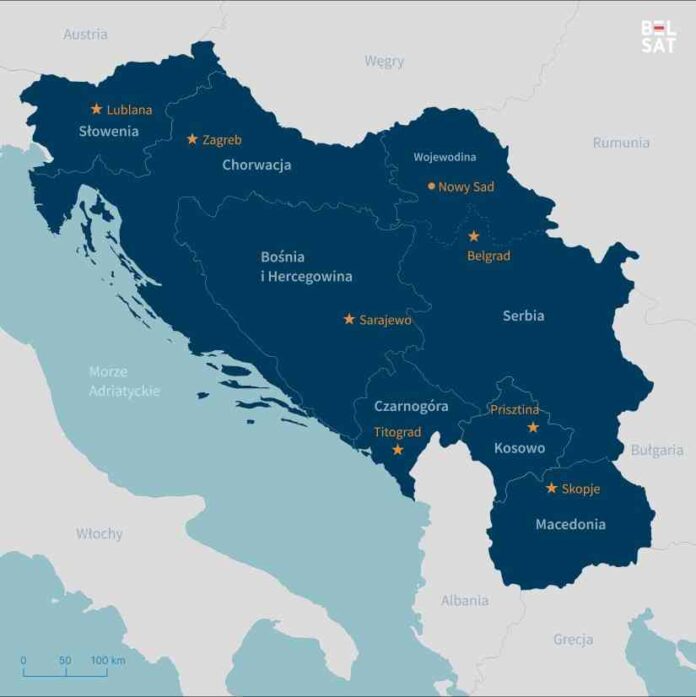The Balkans is a region with a complicated history and current situation. Therefore, with particular emphasis on the area of the former Yugoslavia, they are used in the Kremlin’s disinformation war against Ukraine and the West. The history of the Balkans even justifies Russia’s aggression, and the Kremlin takes advantage of the lack of knowledge on this topic among its citizens and residents of the West. Furthermore, these region’s countries’ political approaches have become even more critical in the present international situation. It is worth noting the Balkans were a gray zone of European security guarantee for many years.
This subjective compendium’s first part is devoted to raising awareness about Russian and pro-Russian propaganda narratives regarding the recent Balkan history. Russian politicians, now and then, express opinions on this subject that legitimize their neo-imperial policy full of many war atrocities.
Disintegration of Yugoslavia
The Kremlin and its propaganda often claim that the West, especially Germany, “has broken down Yugoslavia.” Serbian nationalists maintain the same rhetoric.
Meanwhile, the process of disintegration in Yugoslavia began as early as the 1960s during the so-called Croatian Spring. They speeded up after adopting the constitution in 1974 and after the death of Josip Broz-Tito, the founder of communist Yugoslavia, in 1980. The legislation gave a wide range of competencies to local party nomenclatures.
The administrative division of the Socialist Federal Republic of Yugoslavia after 1974. Podgorica, the capital of Montenegro, was called Titograd during the communist era. Only Macedonia today, North Macedonia, and Montenegro seceded from Yugoslavia bloodlessly. Map: The Belsat, according to Wikimedia
The West itself recognized the Unity of Yugoslavia practically until its very end. Western countries also have not supported, since the mid-1980s, the actions of the elites of the republics heading toward greater independence. It was a situation analogous to the policy of the USA and its allies towards the political changes in the USSR, almost to the end of its existence. With US President George Bush Sr. during his term, the West openly expressed the need to maintain the Soviet Union.
Moreover, the West withheld itself from involvement in military intervention in the Balkans for years. Only a few UN troops were deployed in Croatia and Bosnia, and they had virtually no authorization to take military action.
According to some researchers, the Serbian politician – and then dictator – Slobodan Milošević enjoyed the quiet support of the USA at the beginning of his career. In their opinion, Washington viewed him as a representative of a new generation of Yugoslav politics and a bureaucratic, authoritarian, and corrupt system reformer.
As a next step, the West chose Yugoslav Prime Minister Ante Marković, of Croatian descent, who tried to reform and modernize Yugoslavia economically in cooperation with the International Monetary Fund. Milošević, at the same time, tried, as it turned out successfully, to prevent him from doing so. He strived to build a “great Serbia” or a new Yugoslavia dominated by Serbs. Like all members of the Yugoslav elites from the Communist party, this politician combined elements of nationalism and communism in his rhetoric.
Croatia and Slovenia declared Independence in June 1991. They have previously expressed the desire to transform Yugoslavia into a confederation structure. This effort caused Serbian aggression. The Serbs already controlled the Yugoslav army then. The first target was Slovenia. However, the Yugoslav People’s Army had to withdraw due to the resistance of the Slovenes and the lack of public support. During that specific moment, the Minister of National Defense of Slovenia was Janez Janša. In March 2022, he visited Kyiv, besieged by Russia, with the Prime Ministers of Poland and the Czech Republic.
After Slovenia, Milošević’s next goal was Croatia, the territory where a large-scale war began.
Croatia’s President was Franjo Tudjman back then. Western countries recognized Slovenia and Croatia after about half a year. This historical event occurred after Croatian Vukovar’s destruction and the first war crimes committed by the Serbs against the city’s residents and prisoners of war. In that dramatic period, the pearl of European architecture – Dubrovnik was also shelled. It influenced the elite and public opinion views in the West.
Germany was among the first countries to recognize Slovenia and Croatia’s independence. The end stage of this process happened in 1992. Slovenia was recognized a little earlier, at the end of 1991. The first nations to officially acknowledge the capital, Ljubljana, were the ones separating from the USSR, such as Ukraine and Belarus. The Holy See was also actively engaged in the development of political changes in that region. As a result of the personal involvement of Pope John Paul II in the process, he has since been considered a hero in Croatia.
The West recognized Bosnia and Herzegovina a few months after the war started in that area, initiated by Bosnian Serbs supported by Belgrade.
They demolished Yugoslavia with bombs
Another central theme line of Moscow’s propaganda to justify warfare aggression in Ukraine is that NATO carried out military intervention in the Balkans. This narrative ignores facts that long before NATO intervened, Vukovar, Sarajevo, and Dubrovnik were destroyed by Serbian bombs. The Russian phrase “bombili Yugoslaviyu” (бомбили Югославию) means they demolished Yugoslavia with bombs and is addressed at NATO. It often appears in the statements of the Russian politicians, propagandists, and average Russians. They collate Yugoslavia’s relatively limited number of precision bombardments in 1999, consisting only of Serbia, Kosovo, and Montenegro, with the massive, multi-week shelling of civilian targets in Ukraine. Moreover, most of these attacks are made with inaccurate missiles.
An example of this disinformation is part of Vladimir Putin’s speech on February 24, 2022. He talked about a bloody military operation against Belgrade with the use of aviation and missiles in the heart of Europe that day. In addition, Belarusian leader Alyaksandr Lukashenka said in 2019:
– Let’s talk about NATO for a moment. Why did they bomb Yugoslavia? And why did they split the country into pieces? All because it is easier this way to control this territory.
There were two NATO military interventions in the Balkans. The first was named Deliberate Operation Force and took place in the summer and fall of 1995. These were small-scale air strikes using aircraft, rockets, and other missiles against Bosnian Serb military positions authorized by the UN. They supported Croation-Bosnian ground counteroffensives in Croatia and Bosnia.
These military actions ended the bloody wars in Croatia and Bosnia. According to various estimates, between 100,000 and 200,000 victims died. Hence, Croatia regained all the territories occupied by the Serbs since 1991. Also, a ceasefire was reached in Bosnia. Later on, as a result of the peace conference in Dayton (USA), Bosnia became a confederate state of Bosnian (Muslim), Croatian, and Serbian communities (Republika Srpska in Bosnia), with a rotating leadership.
Although nearly 30 years have passed, Bosnia still needs to be an integrated state which can develop independently. The situation is uncertain, and before the full-scale Russian aggression against Ukraine, it was very tense. International military forces have been deployed in the country. To this day, a contingent of several thousand soldiers remains there. They are currently under the auspices of the EU.
Bosnia with Croatia and Yugoslavia, created only by Serbia and Montenegro then, were subject to an arms embargo. The weapons arrived solely illegally. Contrary to existing Western support for Ukraine, Croatia, and Bosnia did not receive weapons from NATO countries. Greater, but still very limited, support appeared towards the war’s end. The USA supplied the Croatian army with post-Soviet and partially Western weapons. The US participated in the training of the Croats before the counteroffensives in 1995.
The second NATO intervention in the Balkans occurred in the Spring of 1999. It was an operation unauthorized by the United Nations on a much larger scale than in 1995. The goal of the US and its allies was to stop the war in Kosovo and the crimes being committed against Albanian civilians. Apart from Greece’s protests, the Alliance’s countries demonstrated a joint decision to support Croatia.
What was the genesis of this intervention? The persecution of the Albanian residents in Kosovo has been going on for several decades. The Albanians made up the majority of the population in the region, considered the historical cradle of Serbian statehood. After the collapse of communist Yugoslavia, Kosovo Albanians used tactics of passive resistance and building up their underground structures. Finally, the wars in Bosnia and Croatia ended. Serbia weakened, and the idea of armed opposition lasted in the hearts of the Kosovars. The Kosovo Liberation Army (KLA) was formed. It carried out attacks on Serbian soldiers and police officers. In reaction, the regime of Slobodan Milošević launched a brutal pacification of Kosovo. The KLA responded with acts of retaliation. Hundreds of thousands of Albanian civilians were forcibly displaced to neighboring countries like Macedonia, Montenegro, and Albania.
To prevent further destabilization and the next war in the Balkans, also the possibility of another genocide from happening again, the US and its allies decided to launch Operation Allied Force. Consequently, the Serbian army air fleet was destroyed, with the USA minimal losses. The targets of the operation were military facilities and infrastructure, such as bridges used by the army. The state regime television in Belgrade also partook in the bombardment. Before the bombing of its headquarters, NATO was supposed to warn the Serbian side of the attack. However, the authorities did not pass this information on to the employees for unexplained up to now reasons. Sixteen people got killed.
Finally, after about two months of military action, the Serbian regime agreed to withdraw its forces from Kosovo. The stabilization troops, not just from NATO countries, replaced them. It was done as part of Mission KFOR, already authorized by the United Nations. The following year, Milošević was overthrown. In 2001 he was arrested and sent to the Hague by the new Serbian authorities.
Although Montenegro was still formally part of Yugoslavia, its leader Milo Djukanović already in the 1990s, aspired for independence. Montenegro became an independent state in 2006. It is currently a member of NATO. Djukanović remains in charge of the country.
NATO operations in the Balkans aimed not to kill residents or conquests but to prevent further wars and crimes. Civilian casualties are collateral damage due to unfortunate, not-done-by-purpose missile guidance errors or civilians getting too close to the target zone. There were several hundred civilian losses during Operation Allied Force, with roughly half of them being Albanians from Kosovo, as it was in Kosovo that the most intensive bombing of Serbian military facilities took place.
Kosovo’s Independence and Crimea
Another line of Russian propaganda is to compare the independence of Kosovo with the annexation of Crimea by Russia. However, the situation differs both legally and politically. Kosovo had autonomy within Serbia, which was part of Yugoslavia. Yugoslavia, also the one trimmed and altered to just Serbia and Montenegro territory after 1992, was a federal state. Ukraine is a unitary state. Although Crimea, as part of Ukraine, is formally an autonomous republic. In addition, a referendum was held in Kosovo under international auspices. In Crimea, the dubious referendum was held under the supervision of the occupying Russian forces.
Some observers still consider recognizing Kosovo’s independence a political mistake, as it gave Russia an excuse for aggression against Georgia and Ukraine. Moreover, it weakened pro-Western and reformist forces in Serbia in favor of those associated with the former government control administration. Thus, Serbia has been ruled by the Serbian Progressive Party for a decade, whose politicians were linked with Milošević’s regime. President Aleksandar Vučić leads the Party.
There is one more aspect to emphasize. Many Serbs feel victimized by the loss of Kosovo. However, in Bosnia, the world recognizes a legal entity, Republika Srpska, which borders largely coincide with the territories occupied by the Serbs during the war. Republika Srpska in Bosnia, violating the Dayton Agreement now and then, occasionally tries to pursue its own foreign policy agenda. The Serbian minority also lives in Croatia and enjoys the freedom rights guaranteed by the EU. There is even a Serbian minority party in the Croatian parliament, which joined the ruling coalition in 2020.
Srebrenica
Before the Russian aggression against Ukraine, the events in Srebrenica in July 1995 were the only case of genocide in Europe after World War II. Years later, the UN Tribunal for War Crimes in the Former Yugoslavia sentenced the leader of the Bosnian Serbs, Radovan Karadžic, and the commander-in-chief of the Bosnian Serb Army, General Ratko Mladic, to life imprisonment. Slobodan Milošević died in The Hague during his trial in 2006. Yet, proving his guilt and involvement in the atrocities committed as the perpetrator of the aggression against Bosnia and Croatia was difficult. Serbia was not formally a party to this war.
The reprisals by Bosnians and Serbs were too a part of that war reality. The Serbs murdered over 8,000 Bosnian men and boys from Srebrenica. Earlier, war crimes and ethnic cleansing were also committed by Serbian troops. There was also a bloody conflict between the Croats and Bosnians (Muslims) of Bosnia at one point in the war.
The Serbian and the Russian propaganda tried to relativize the massacre in Srebrenica. They claimed that all sides committed crimes, and the Serbs suffered equally. However, a planned war atrocity on such a scale was performed only by the Bosnian Serb Army in Srebrenica. The Serbian side also began to apply the criminal policy of the so-called ethnic cleansing and has implemented it consistently on a large scale. At the same time, most Serbian societies did not support the war. It is a notable difference in comparison with the case of the Russian position on the current invasion of Ukraine.
After Srebrenica, the Bosnian-Croatian counteroffensive and NATO air strikes stopped the Serb’s military attacks.
The horrific events in Srebrenica are relativized in propaganda by recalling that the city had defended itself for many months. Even though the UN declared it a safe zone, the town was constantly attacked. Bosnian troops under the command of Nasser Orić carried out diversion acts behind the front lines of Serbian forces and were accused of war crimes. The atrocities in Srebrenica would thus be a spontaneous and justified revenge for the aggression of Oric’s troops. However, after several years of trial, The Hague Tribunal cleared Orić of war crimes charges. In addition, when the Serbian army entered the city, there were no more of his military men.
The war in the former Yugoslavia and Russia
According to the current state of research, Russia had no connection whatsoever with the wars in the former Yugoslavia. The country was weak and dealt with its troubles. Recently a former Russian Deputy Prime Minister and ex-Chief Head of Staff of Roscosmos, Dmitry Rogozin, declared that Karadžić and Mladić were heroes and his friends. He often had meetings with them in 1994-96. Rogozin is well known for his chauvinist views. He previously participated in the Russian aggression against Moldova. His statements will undoubtedly be considered in further investigating the wars in the former Yugoslavia.
There is no secret anymore that Russian chauvinists came to Republika Srpska in Bosnia as mercenaries or “guests” during the war. For instance, the Head of the so-called Nationalist Bolshevik movement and writer Eduard Limonov visited Bosnian Serb troops and spoke with Karadžic. He observed the shelling of the capital of Bosnia, Sarajevo. He fired his rifle toward the city as well. The proof footage of this event was recorded.
Igor Girkin-Strelkov, the former Donetsk People’s Republic commander and its so-called Minister of Defense, associated with the FSS, was actively involved in military combat with the Serbian troops. He is currently criticizing the Kremlin from a nationalist point of view.
After the withdrawal of Serbian troops from Kosovo in June 1999, the so-called incident in Pristina. After the Dayton agreement, Russia sent stabilization forces to Bosnia as part of the international IFOR/SFOR Mission. They were deployed in Republika Srpska in Bosnia. At the same time, Russia deployed these troops to the airport in Kosovo. There are many indications that it was a tactical move to accept the Russian landing. It is a high possibility the next step would have been creating a Russian-Serbian zone in Kosovo. However, NATO upheld a firm position during this encounter. After several hours of “stand-off” between the Alliance and the Russian military troops, the Russians withdrew. The Russian Armed Forces units involved in this incident were commanded by the current Russian Deputy Defense Minister Yunus-biek Yevkurov, a longtime trusted friend of Vladimir Putin.
End of part one
Marcin Herman/belsat.eu
The second part of the compendium will be devoted to politics and social attitudes in individual Balkan countries towards Russia, the West, and Ukraine.
Translated by PEV.
























